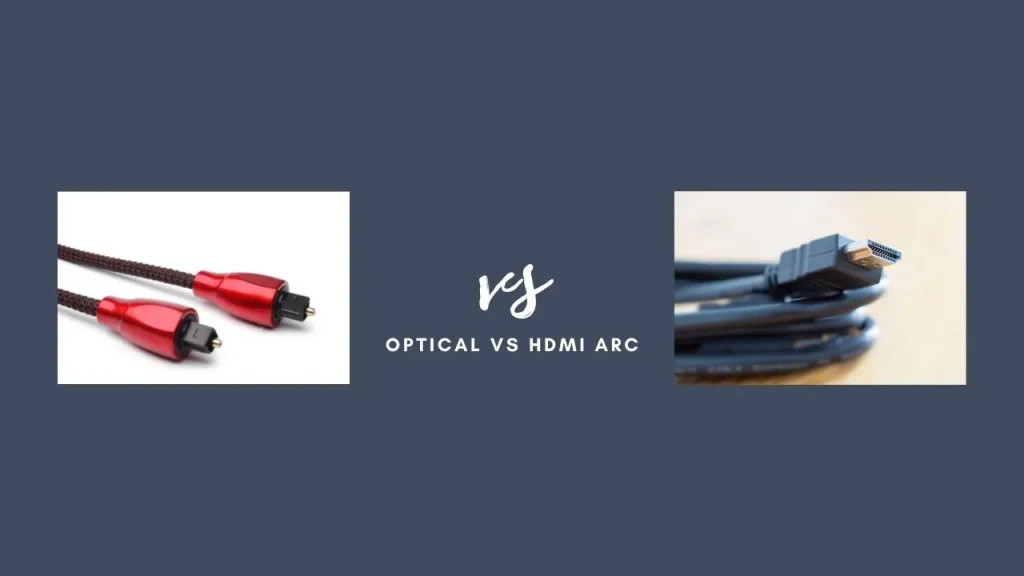The most common debate for connecting expansive A/V systems or soundbars to your media players is between HDMI ARC vs Optical. How do they differ?
HDMI ARC is better at delivering sound and video. However, its competitor wins in terms of cable length and construction. This article will explain the differences between the two connections in detail. Let’s read on to discover!
Read also: Soundbar Vs Soundbase
What Is HDMI ARC?

HDMI stands for High Definition Multimedia Interface. It is the most common consumer HD transmission for sending high-definition audio and video from a device to a monitor. This format is also famous for most consumer items, and it’s also popular in the commercial A/V market.
Since the technology’s first introduction, many versions of this line have come out, with the most recent 2.1 variants providing adequate bandwidth for console gamers to operate at 120Hz.
ARC stands for Audio Return Channel. It employs one single high-speed connection to link your screen to your sound system, removing the need for an extra audio line.
What Is Optical?

Optical audio, also known as TOSLINK, is a standard optical fiber connection technology that enables audio to travel from one device to a soundbar or an AV receiver. In consumer sound equipment life, you often see this system DVD/CD players, DAT recorders, and game consoles. It allows the transmission of sound from one input to an output channel.
The technology first appeared in the 80s, developed by Toshiba. It then became increasingly popular in the next decade. Many people considered TOSLINK as the quickest way to get DTS and Dolby Digital from your satellite box to the AV receiver during its peak.
Differences Between HDMI ARC Vs Optical

These connections are both popular. However, while the ARC seems more prominent among advanced devices, old gadgets work better with the optical.
Audio quality
Both can transfer multi-channel sound from one device to another. They also support a large number of audio files.
Optical cables can only provide 5.1 surround sound, which means they can only broadcast stereo, DTS, and Dolby Digital.
On the other hand, HDMI ARC enables various audio formats such as stereo, Dolby Atmos, DTS:X, DTS HD, and Dolby TrueHD for more modern gadgets.
Despite the lack of 7.1 surround loudspeakers, this system offers more audio formats than its competitor.
Read also: 5.1 Vs 7.1 Sound System: Which Is Better For A Home Theater Setup?
Video quality
Optical cables, sadly, do not support video. This feature is one of the main reasons people choose HDMI ARC cables over standard versions. Each HDMI wire, however, offers a different visual quality.
HDMI 2.1 cables, for example, can transmit 120 frames per second in 4K videos, but 2.0 cables can only provide 60 frames per second in 4K.
Build

Another critical distinction between these connections is the material structure. ARC cables are mainly copper, a common material for electronic cables due to their durability and low cost.
Optical cables, on the other hand, are glass fiber optic strings. They are more expensive to manufacture than copper.
The transmission is the primary difference between the materials, aside from the construction.
Since optical wires send signals by light instead of electrical currents, they are not vulnerable to electromagnetic interference.
How does light carry data? This video will give you a complete explanation of this process.
Input options
Although ARC cables are pretty popular, not all electrical gadgets offer the compatible input option. You’ll have to find the optic for older devices.
More current devices can work with the ARC cords. As a result, if you’re not planning to update a new system, optical cables will suffice.
Cable length
The cable length plays a vital role in sound quality and interference. However, most people don’t care because they place TVs, soundbars, and A/V receivers close to each other.
Optical wires can maintain sound quality at a maximum range of 30 meters. If you want a strong connection across your house, this option sounds great.
On the other hand, the ARC cables decrease audio quality after 15 meters. The reason behind this drawback is that the wires employ low voltage. Hence, they can’t carry very long signals.
Comparison table
| Criteria | HDMI ARC | Optical |
| Audio | 5.1 surround sound | 5.1 surround sound |
| Video | Yes | No |
| Build | Material: Copper Run by: electrical currents |
Material: Glass Run by: light |
| Input options | Compatible with newer devices | Compatible with older devices |
| Cable length | 15 meters | 30 meters |
Final Verdict: Which Is Better?
The decision on what to choose between the two connections comes down to what divides you have at hand. If you are working with older gadgets and they stay away from each other, an optical cable should be your way to go. However, it can’t support the video. On the other hand, if you use modern devices and need a visual display, then HDMI ARC is better.
Hopefully, the side-by-side comparison we have shared can help you choose the better connection for your home setup. Thank you for reading!






